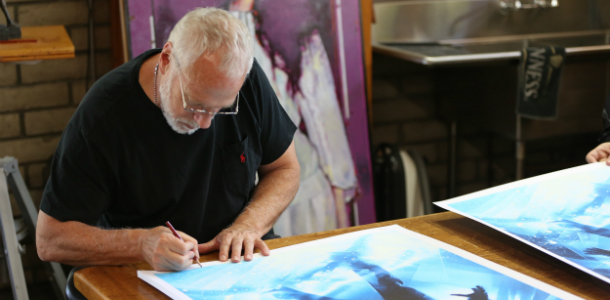Sharkey Shines A Light On Struzen, Misses The Mark
All said and done, the film is mostly just a slide show of Struzen’s extensive artwork with an A-list cast of interviewees endlessly complementing, while the artist himself sits before the camera, struggling to divulge details about his own life. Obviously a man who enjoys working in solitary and finds no satisfaction in self-aggrandization, he’s awkward before Sharkey’s lens. Like a humbled actor accepting an Oscar at the Academy Awards, he seems genuinely baffled that people would be interested in his life, and thus he is rendered somewhat speechless. His upbringing seems a sore spot, so it’s merely given a passing glance. Similarly, his love life is devoid of drama, marrying young and staying faithfully so since. It is only in Drew’s professional life that the cinematic conflicts occur, but even they aren’t given the weight necessary to create any dramatic tension.
He endured the clichéd life of a literally starving artist until his break in painting record covers for the likes of Black Sabbath and Alice Cooper. From there, he was whisked off by the hands of Hollywood, with their deeper wallets and bigger promises, and generally life was good and his artwork even better. As a painter, he continued to grow, but as a businessman he lacked the skills to protect himself, and thus, he was swindled for nearly a hundred original works, until the thief died in the midst of legal battle for the collection. Though its the only real conflict in the film, the traumatic tail is only given tangential screen time, instead Sharkey focuses on the star power interviews and their anecdotal experiences of working with the artist, missing even the opportunity to thoroughly delve into Struzen’s unique techniques.
Breathing life into this surface level experience, Spielberg and del Toro lend the most emotion to the project, each giving loving, lengthy and hilariously honest yarns on how Struzen’s work has embodied pop film culture for generations. Coming late to the Struzen party, del Toro’s unsuccessful experiences of trying to get the studios to employ the painter for Hellboy and Pan’s Labyrinth posters brings up an interesting discussion on the shift away from hand crafted artwork in favor of pixel pushing digitalization, but once again, substance ends up being averted for accolade. I think we can all agree that Drew Struzen deserves a loving ovation, a handshake, and maybe even a pat on the back for all the beautiful, nostalgia inducing work he’s created over the years, but Drew: The Man Behind the Poster should have been more than that.
